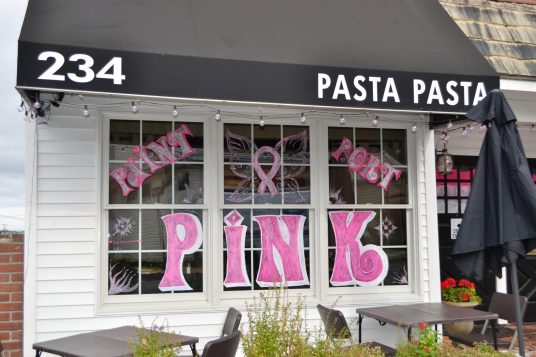Paint Port Pink, Mather Hospital’s annual month-long breast cancer community awareness outreach, kicked off Oct. 1 with the lighting of pink lights by community partners in Port Jefferson, Port Jefferson Station, and surrounding communities. Lamp posts along Main Street in Port Jefferson are aglow with pink lights, along with the Theatre Three marquee and many store windows.
Paint Port Pink’s goal is to raise awareness about breast cancer, encourage annual mammograms, and bring the community together to fight this disease.

Breast cancer is the most common cancer in women in the U.S., except for skin cancers, representing about 30 percent (or one in three) of all new female cancers each year. It is the second leading cause of cancer deaths for women in the U.S. after lung cancer, according to the American Cancer Society. Every two minutes someone is newly diagnosed with invasive breast cancer (Breast Cancer Research Foundation).Only one in three women over 40 have an annual mammogram.
Paint Port Pink will feature a special HealthyU webinar on Women’s Health on Tuesday, Oct. 11 at noon. Three physicians will talk about breast cancer, menopause, and mental health during the pandemic. Register at matherhospital.org/healthyu
Oct. 14 is “Wear Pink Day” and everyone — and their pets — are encouraged to get their pink on to raise awareness. Post photos on social media with #paintportpink and send them to [email protected] to be posted on our Facebook page.
Decorate your business window for a chance to win tickets to a 2023 concert at Jones Beach. Send photos of your window by Oct. 20 to [email protected]
The event’s popular “Pink Your Pumpkin” contest returns and encourages everyone to get creative with their pumpkins for a cause. Photos should be emailed to [email protected] by Oct. 24 and posted on social media with #paintportpink. The winner will be chosen Oct. 25 and will receive a $100 gift card.
Paint Port Pink community sponsors include New York Cancer & Blood Specialists, Lippencott Financial Group, Riverhead Toyota, and Accelerated Services Inc., Po’ Boy Brewery , Tuscany Gourmet Market, Bohemia Garden Center, Brookhaven Expeditors, C. Tech Collections, Michael R. Sceiford Financial Advisor/ Edward Jones, PAP Landscape and Design, Inc., Precision Lawn Irrigation, and Swim King Pools and Patios.
A full calendar of events and a list of Paint Port Pink community partners offering promotions to benefit The Fortunato Breast Health Center is available at www.paintportpink.org. Call 631-476-2723
From despair to hope: A breast cancer survivor’s story
By Jennifer Van Trettner

It was late Friday morning on a cool December day when my phone rang. It was the (Fortunato) Breast Center calling about my routine mammogram that I had two days prior. I took a deep breath and hesitantly answered the phone. Marianne, the nurse on the other end, introduced herself and told me in a kind, warm voice that the doctor saw something of concern on my imaging and asked if I could come in for a biopsy within the hour. I said yes before I even had time to exhale.
I drove to the Breast Center alone. All sorts of thoughts were running through my head. Shortly after arrival, I was escorted to the sonogram area by a friendly woman and was given a warm gown. I undressed, wrapped myself in the warm, pink gown, and sat in the waiting room.
A few minutes later, I was called into the sonogram room. The technician, whom I had met on several occasions, was lovely. The doctor was the same one who did my last biopsy. She explained to me that six tissue samples would be taken from my left breast.
On Tuesday, December 21, 2021, the Breast Center called. I felt my heart plummet into my stomach and knew my life was about to change forever. As if in slow motion, I answered the call. If I close my eyes, I can still hear Marianne’s voice saying they received my biopsy results and asking if I could come to the breast center that day. This time I didn’t want to go alone. My mother-in-law, a breast cancer survivor, went with me (my mother, also a breast cancer survivor, lives in Georgia).
With masks on, we walked into the Breast Center and were immediately brought into the office. It was warm and inviting. The doctor came in, introduced herself to my mother-in-law and sat in a chair at the end of the desk, almost directly in front of me. I could feel my eyes welling with tears.
I was told my biopsy was positive for IDC (Invasive Ductal Carcinoma) breast cancer. It was stage 1, estrogen positive, and Her2+. Relatively speaking, it was a good scenario. Marianne held up a pretty, clear box of pearls ranging from 2mm up to 20mm. She took out a 10mm pearl, placed it in my hand and told me this was the approximate size of my cancer. As I held the pearl in my hand, I thought what a nice, kind, warm, and non-scary way to confirm a woman’s fear.
Marianne, having years of my personal information in front of her, explained how she already called and made appointments with the doctors I would need to see.
I called my mom from the office. I really needed to hear her voice. I asked her to get dad and put the phone on speaker. Telling my parents, from hundreds of miles away, their eldest daughter had breast cancer was not easy. I found myself standing at the entrance to a new path, and I wasn’t quite sure how to take the first step. One thing I knew for sure was that I wouldn’t have to take the first step alone. After hanging up with my parents, I was escorted to have an MRI. A few hours later and completely emotionally exhausted, we headed home.
On the morning of December 30, 2021, I saw my surgeon who would remove the cancer and sentinel lymph nodes. In the afternoon I saw the oncologist who had done genetic testing on me two years earlier (all of which were negative). He explained my cancer and the treatment it would require. I would need 12 weeks of chemotherapy and Herceptin infusions once a week for three to seven hours followed by an additional 13 Herceptin infusions every three weeks. Once those were finished (anticipated finish date: 2/8/23), I would need 10 years of Tamoxifen. The same evening, I had a PET scan. Thankfully, there were no surprises.
I started to tell family, friends, and colleagues of my diagnosis. I was immediately touched by the outpouring of love and concern. Helpful gifts began to arrive. The best gifts of all were the arrival of my parents a few days prior to surgery.
My surgery at Mather Hospital was scheduled for January 25, 2022, which at the time of diagnosis felt like years away. In the back of my head was a little voice wondering if my aggressive cancer would get larger and spread during those weeks of waiting. I started an online journal and invited those closest to me to follow.
The warrior in me began to take charge of my treatment, familiarize myself with my cancer, mastectomy options, implant options, and read from cover to cover the amazing book the breast center gave me at time of diagnosis. I reviewed all possible side effects. After that I never looked back.
On the day of surgery, I arrived at the hospital anxious, nervous, and prayed that waking up after surgery was God’s will. I worried about what would happen to my husband and adult children if I didn’t.
I was brought into a large operating room. I fell asleep within seconds of speaking to the anesthesiologist and woke up seven hours later in recovery. The nurses were wonderful. Two of my former students, now nurses working the night shift, visited me bringing with them my favorite sweets, Swedish fish. Seeing familiar, friendly faces that night made my heart happy
Since my surgery, life has had many challenges. The first two weeks post-surgery I spent on the couch with my parents taking care of all household things while my husband went to work. April 14th, I tested positive for COVID, which set me back a week in treatment. Thankfully my oncologist prescribed an antiviral. It helped with my recovery and got me back on track with the infusions.
Treatments began with inserting the IV needle, blood work, Herceptin, a bag of Zofran, a bag of Benadryl and lastly chemo. By treatment six, my hair was very thin, so I decided to take control and shave what was left. The last day of chemo was May 21st, and on May 28th, I began my tri-weekly Herceptin infusions.
Throughout this journey, I have posted consistently on social media. I was born a teacher, and as such I felt it important to share my journey with anyone who wanted to follow. I believe it’s important for me to show my strengths and weaknesses, to be real, raw, and honest. This is a club no one wants to join. In the United States breast cancer affects 1 in 8 women, and on Long Island it’s 1 in 6. I had a support system like no other to help me get through this.
Schedule a mammogram today!
The Fortunato Breast Health Center at Mather Hospital, 75 North Country Road, Port Jefferson uses state-of-the-art breast imaging technology in a warm and assuring environment with a commitment to giving you personalized breast healthcare.
Their staff of professionals provides 3D mammograms and offers individualized follow-up care, education for patients, families, and the community, as well as breast cancer support groups.
Their Breast Center radiologists are specialists who only read breast imaging studies and look back as far as possible at your history of breast images for any subtle changes or abnormalities to provide the most accurate reading.
The Breast Health Center has also partnered with the Suffolk Cancer Services Program (CSP) to provide free breast cancer screenings to individuals who qualify. The CSP provides breast cancer screenings to women age 40 and older without health insurance in Suffolk. If any follow-up testing is needed, the CSP will provide those tests too. If cancer is found, CSP will help enroll people who are eligible in the NYS Medicaid Cancer Treatment Program for full Medicaid coverage during treatment.
To find out if you are eligible for free screenings or to schedule your annual mammogram, call 631-476-2771.
All photos courtesy of Mather Hospital.
































